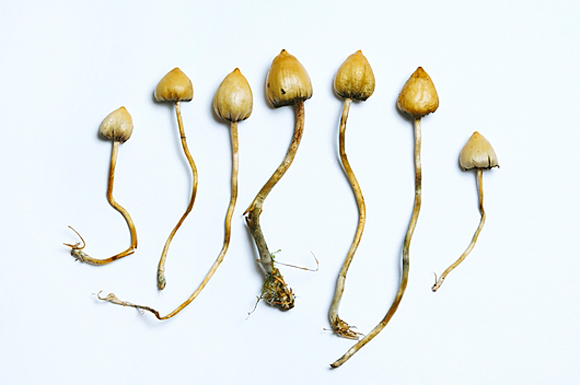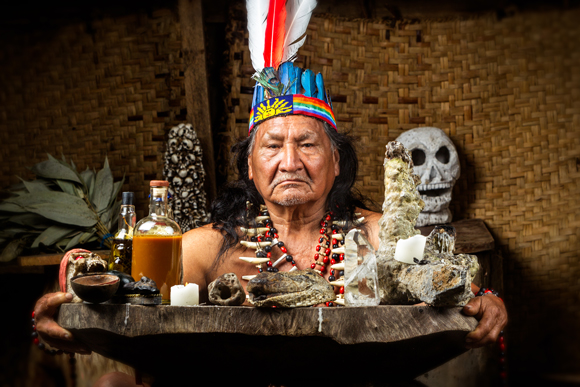Despite concerns about the impacts of consciousness-altering drugs, researchers estimate that they may have been instrumental for the development of complex, thriving human societies
Drugs - substances that affect the activity of the brain and nervous system, have been used by us, humans, for thousands of years. Their mechanisms of action are diverse, but all of them affect our consciousness and alter our sensory perception.
The legal status of drugs and their norms of use vary from time to time and from place to place, but it is quite clear that their use is not an invention of the modern era. Many findings from prehistoric sites indicate that as far back as ancient times humans used drugs to alter their sensory perception and their emotions, and it is even possible that they played a key role in the formation of human society as we know it.

Contains psilocybin that binds to serotonin receptors in extensive areas of the brain. A hallucinogenic fungus | Cordelia Molloy, Science Photo Library
Worldwide Use
In the Càrritx caves on the Spanish island of Menorca, a large burial site dating back to the late Bronze Age, approximately 3,000 years ago, was discovered. The remains of hundreds of human skeletons were found at the site. Some were found in sealed containers with lids decorated with paintings of circles, preserved in a separate space. These airtight containers allowed for relatively good preservation of organic remains such as hair.
A group of researchers from Spain and Chile took advantage of the condition of these remains to examine human hair from the site. Chromatographic analysis, which allows separation of substances based on their chemical properties, revealed in some samples high concentrations of consciousness-altering substances, i.e. drugs likely derived from plants and consumed during a ritual ceremony. In three hair samples, compounds of consciousness-altering substances were found. The first two were atropine and scopolamine - substances that cause hallucinations, a sense of detachment from reality, and changes in sensory perception, likely originating from plants of the nightshade (Solanaceae) family, such as Datura. Another substance found, ephedrine, enhances emotional and physiological arousal. It is derived from a common plant called Ephedra.
Across the Atlantic Ocean, in the Andes Mountains in southern Peru, mummified childer’s remains were discovered, having been sacrificed by members of the Inca civilization, which dominated the region until the 16th century CE, as part of a ritual ceremony known as Capacocha. The remains of hair and nails of the mummies contained significant quantities of cocaine and cocaethylene, both of which are derived from the coca plant. Additionally, traces of mescaline, a psychoactive substance found in the peyote cactus and the San Pedro cactus, native to South America, were also detected.
Mescaline, which binds to the receptors of the neurotransmitter serotonin in the brain, causes hallucinations, distorts the perception of time, and alters visual perception - for example, by causing colors to appear more vivid. Cocaine binds to dopamine receptors in the brain and prevents dopamine reabsorption, thus resulting in dopamine accumulation and sustained elevated levels. Consequently, cocaine users experience heightened energy and euphoria. Cocaine also carries a significant risk of addiction, since dopamine is the neurotransmitter that functions in the reward system - the mechanism that causes us to want more and more of what makes us feel good.
Further south, in the highlands of southwestern Bolivia, ritual vessels, dated to around 1000 CE were found to contain remains of several compounds, including harmine and DMT. The latter is a substance found in the ayahuasca plant (Banisteriopsis caapi) or caapi, also known as the vine of the spirits or vine of the gods. It binds to serotonin receptors in the brain and strongly activates them. Harmine, also found in caapi, inhibits the breakdown of DMT. The combination of the two prolongs the period of activity of DMT, which is consumed through food or drink. The ayahuasca drink, which is still used today in worship and healing rituals practiced in certain communities in South and Central America, is produced from the brewed plants. Those who drink it report visual hallucinations and a sense of euphoria lasting several hours.
Archaeological evidence of the consumption of consciousness-altering substances has also been found in Israel. In a temple dating to the First Temple Period in the Kingdom of Judah, discovered during excavations at Tel Arad, residues of organic material were found on the altar. A detailed analysis of the substance revealed active compounds found in the cannabis plant, which are responsible for its psycho-physiological effects.

Those who consume the drink report visual hallucinations and a feeling of euphoria that lasts several hours. A shaman in Ecuador during the ayahuasca ritual | Ammit Jack, Shutterstock
"The Stoned Ape”
If so, numerous findings suggest that humans consumed mind-altering substances in the distant past, as part of religious worship ceremonies and possibly for other purposes. What drove them to do so and what role did these substances play in the development of human civilization as we know it today?
Biologist and author Terrance McKenna, who explored the connection between human cultures and plants, raised the hypothesis in his book, “Food of the Gods” that hallucinogenic mushrooms may have acted as a catalyst for the development of human society. McKenna, known among other things for advocating the responsible use of hallucinogenic mushrooms, suggested that when early humans migrated northward from the African continent due droughts, they arrived in regions where naturally occurring psychoactive mushrooms that containing the hallucinogenic substance psilocybin grew and consumed them. Psilocybin binds to serotonin receptors in extensive areas of the brain, resulting in a wide range of effects in consciousness, including alterations in sensory perception, emotions, and awareness.
At low doses, psilocybin can sharpen the senses and therefore benefit hunter-gatherers in obtaining food. At higher doses the substance arouses sexual desire, while people who have used very high doses sometimes report mystical experiences such as ego dissolution and a sense of unity with the universe. McKenna’s theory, called “The Stoned Ape Theory”, has not received much support from the scientific community and was largely marginalized. However, in recent years, interest in psychedelic substances has been rekindled.
Psychedelic substances are compounds that affect the state of consciousness, sensory perception, and more, and sometimes cause hallucinations and changes in self-awareness. In a 2021 paper, anthropologists Michel Winkelman and Jose Arce presented various findings suggesting that the consumption of psychedelic substances provided evolutionary advantages—that is, individuals and human communities that consumed substances with psychedelic effects benefitted from characteristics that made it easier for them to adapt to their environment and to the changing world around them.
However this claim has a caveat: usually, when we talk about evolution, we’re referring to the biological transfer of traits from one generation to another - through our genes. Psychedelic substances don’t alter the genetic material in our cells, so we’re not talking about genetic traits, but rather behavioral and social patterns that may have conferred a survival advantage to the group that adopted them. For example, psilocybin, the active substance in psychedelic mushrooms, can be useful for coping with stress and anxiety and encourage flexibility of thought and creativity. Phenomena such as ego dissolution may forster empathy and reinforce social connections between individuals in a group, while the sense of oneness can play a role in tribal-worship ceremonies, formulation of shared values and decision making as a group.
Humans are social beings. Early humans depended on their tribe or group's support for survival. Even in modern society, the recent COVID-19 pandemic has reminded us of the vital importance of our social connections for our physical and emotional well-being. According to the researchers, the use of mind-altering substances, particularly psychedelic substances such as psilocybin, may have advanced the development of complex social relationships, cooperation, and rich forms of human communication. Human societies that adopted abilities, customs and norms that encouraged well-developed social relationships enjoyed an evolutionary advantage that created a positive feedback loop, refining human communication patterns over time, ultimately contributing to the rich oral communication we have today.
In recent years we’ve witnessed a revival of research and medical and mental treatment using mind-altering substances. Findings demonstrate that when used prudently, such substances may offer benefits to certain populations. Presently, most countries have strict regulations on the use and distribution of most consciousness-altering substances. However, the legal status of such substances changed in the past, and it may change again in the future, if accumulating research provides evidence that such a change is indeed necessary. Alongside the concerns associated with their use, the growing awareness of their potential therapeutic and medical benefits, it’s worth remembering that the use of mind-altering substances has been part of human history since its earliest days.
